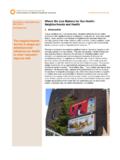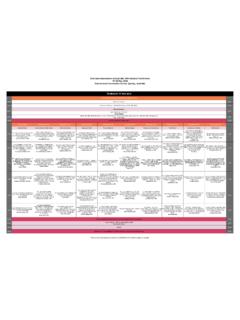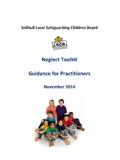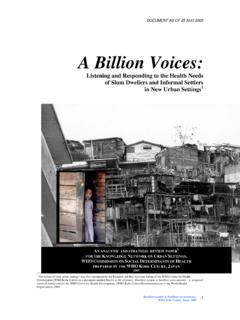Transcription of Between Education and Obesity Exploring the Relationship
1 From:OECD Journal: Economic StudiesAccess the journal at: the RelationshipBetween Education and ObesityMarion Devaux, Franco Sassi, Jody Church,Michele Cecchini, Francesca BorgonoviPlease cite this article as:Devaux, Marion , et al. (2011), Exploring the Relationship BetweenEducation and Obesity , OECD Journal: Economic Studies, document and any map included herein are without prejudice to the status of orsovereignty over any territory, to the delimitation of international frontiers and boundaries and tothe name of any territory, city or Journal: Economic StudiesVolume 2011 OECD 2011121 Exploring the Relationship Between Education and ObesitybyMarion Devaux, Franco Sassi, Jody Church, Michele Cecchini and Francesca Borgonovi*An epidemic of Obesity has been developing in virtually all OECD countries over thelast 30 years. Existing evidence provides a strong suggestion that such an epidemichas affected certain social groups more than others.
2 In particular, a better educationappears to be associated with a lower likelihood of Obesity , especially amongwomen. This paper sheds light on the nature and the strength of the correlationbetween Education and Obesity . Analyses of health survey data from Australia,Canada, England, and Korea were undertaken with the aim of Exploring thisrelationship. Social gradients in Obesity were assessed across the entire educationspectrum, overall and in different population sub-groups. Furthermore,investigations testing for mediation effects and for the causal nature of the linksobserved were undertaken to better understand the underlying mechanisms of therelationship Between Education and classification: I12, I21 Keywords: Obesity , Education , social disparities, mediation effect* Marion Devaux Franco Sassi and Michele all work in the Health Division of the OECD Directorate for Employment,Labour and Social Affairs, Francesca Borgonovi works in theIndicators and Analysis Division of the OECD Directorate for Education and Jody is at the Centre for Health Economics Research and Evaluation, Universityof Technology in Sydney, Australia.
3 The views expressed are those of the authors and should not beinterpreted as representing those of the OECD or its member THE Relationship Between Education AND OBESITYOECD JOURNAL: ECONOMIC STUDIES VOLUME 2011 OECD 2011122 Overweight and Obesity rates have been increasing sharply over recent decades in allindustrialised countries, as well as in many lower-income countries. The rise in Obesity hasreached epidemic proportions, with over 1 billion adults worldwide estimated to beoverweight and at least 300 million of those considered to be clinically obese (WHO, 2003).The circumstances in which people have been leading their lives over the past 20-30 years,including physical, social and economic environments, have exerted powerful influenceson their overall calorie intake, on the composition of their diets and on the frequency andintensity of physical activity at work, at home and during leisure time.
4 On the other hand,changing individual attitudes, reflecting the long-term influences of improved educationand socio-economic status (SES) have countered to some extent environmental OECD countries have been concerned not only about the pace of the increase inoverweight and Obesity , but also about inequalities in their distribution across socialgroups, particularly by level of Education , socio-economic status and ethnic across social groups appear to be particularly large in women (Wardle et al.,2002; Branca et al., 2007). Acting on the mechanisms that make individuals who are poorlyeducated and in disadvantaged socio-economic circumstances so vulnerable to Obesity ,and those at the other end of the socio-economic spectrum much more able to handleobesogenic environments, is of great importance not just as a way of redressing existinginequalities, but also because of its potential effect on overall social welfare.
5 The currentdistribution of Obesity appears particularly undesirable, as it is likely to perpetuate thevicious circle linking Obesity and disadvantage by intergenerational has produced ample evidence of the individual labour market returns ofeducation. Economists have shown much interest in the estimation of the causal effect ofeducation on wages and economic growth (see Card 2001, for a comprehensive review of theliterature) but only recently has work begun to investigate the non monetary returns ofschooling (see McMahon, 2004 for a review). Empirical studies, for example, suggest thateducation has a positive impact on health and well-being (Wolfe and Haveman 2002; Lleras-Muney 2005), particularly in poorer countries (Cutler and Lleras-Muney, 2006), reduces crime(Lochner and Moretti 2004) and water and air pollution (Appiah and McMahon 2002). Thefinding that Education has positive externalities provides a rationale for , the causal nature of the link Between Education and health is still subject to acertain degree of scrutiny, and the precise mechanisms through which Education may affecthealth are not yet fully understood.
6 Lifestyles may be one of the keys to understanding such arelationship, as they are often significantly influenced by Education and, at the same time, theycontribute to health and longevity by affecting the probability of developing a wide range ofdiseases. Obesity is a close marker of important aspects of individual lifestyles, such as dietand physical activity, and is also an important risk factor for major chronic diseases, such asdiabetes, heart disease, stroke and certain cancers. Obesity is also associated with negativelabour market outcomes, in term of both wages and employment, particularly for women(Cawley, 2004; Brunello et al., 2006). Exploring THE Relationship Between Education AND OBESITYOECD JOURNAL: ECONOMIC STUDIES VOLUME 2011 OECD 2011123 The aim of this paper is to provide new evidence concerning the Relationship betweeneducation and Obesity and contribute to understand the nature of such Relationship and itsimplications for health and Education policy.
7 The empirical analyses on Education andobesity undertaken by the OECD focus on four countries: Australia, Canada, England andKorea. Data from health surveys regularly undertaken in the four countries were used in arange of analyses, in pursuit of the following specific objectives:1. To explore the correlation Between body mass index, and Obesity , on one hand, and formaleducation, expressed in terms of years spent in full-time Education , on the other, controllingfor possible confounding factors. The main goal of this analysis is to determine whether theintensity of the Relationship Between Education and Obesity is constant, or whether it showsincreasing or decreasing strength at either end of the Education To assess the extent to which the correlations identified may reflect the influences of factorsassociated with individual Education , such as socio-economic status and the level ofeducation of household To assess the extent to which the correlations identified may reflect causal links betweeneducation and To explore what conceptual model of the role of Education as a determinant of health ismost consistently supported by the findings concerning the correlation Between Obesity andaspects of individual and group descriptionThe analyses reported in this paper are based on individual-level national health surveys covering fourOECD countries.
8 Australia, Canada, England and Korea. Data sources include the Australian National HealthSurvey (NHS) 1989-2005, the Canadian National Population Health Survey cross-section (NPHS) and theCanadian Community Health Survey (CCHS) 1995-2005, the Health Survey for England (HSE) 1991-2005 and theKorean National Health and Nutrition Examination Survey (KNHANES) 1998-2005. All available survey waveswere pooled for each survey. Since the focus of the analyses was the Relationship Between Obesity andeducation, survey samples were restricted to individuals in the age range 25-64 who were supposed to havecompleted their full time Education , and for whom the body mass index is a useful proxy for health risk. Bodymass index (BMI) was calculated as weight in kilograms divided by square height in meters. Obesity andoverweight status were then derived as BMI greater than 30 and analyses were conducted by applying the same models to all countries data, in order to facilitatecomparisons across countries.
9 However, differences in data and survey methods sometimes make it difficultto achieve complete consistency. For instance, data on height and weight were measured by examination inEngland and Korea while they were self-reported in the other two countries. The Education variable wasobviously a critical one, and the format of this variable varied across countries. We created a variable reflectingthe numbers of years spent by each individual in full-time Education using all the information available ineach dataset on years of schooling and educational attainment. For consistency, we grouped togetherindividuals with no Education and those with the lowest level of Education , as these two groups were notalways separated in the available datasets. A certain degree of heterogeneity was also present in relation to thesocio-economic status (SES) variable, as occupation-based social class was reported in the English data, whileequivalised household income was available in Australia, Canada and Korea.
10 Individuals were allocated toincome quintiles in Australia and Korea, and to income groups based on fixed income ranges in , an ethnicity variable was available in England, while proxies were used in Canada (minority status) andAustralia (migrant status). No such variable was available in Korea. Tables of descriptive statistics arepresented in Annex THE Relationship Between Education AND OBESITYOECD JOURNAL: ECONOMIC STUDIES VOLUME 2011 OECD 20111241. Existing evidence on the Relationship Between Education and obesityThe existing evidence concerning the Relationship Between Education and Obesity isrelatively limited, as the main focus of most research has been more broadly on the linksbetween socio-economic factors and health status, or longevity, with a smaller number ofstudies focusing on lifestyles and on Obesity in particular. The evidence available, coveringa number of OECD countries, generally shows strong associations Between Education andobesity.

















